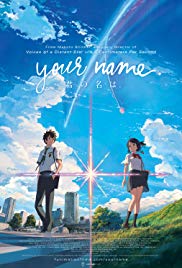
YOUR NAME/ KIMI NO NA WA
Japan, 2016, 104 minutes, Colour.
Directed by Makoto Shinkai.
This Japanese anime film was very popular around the world, especially in Japan and China.
In its many surfaces, it seems like an ordinary narrative, about a young girl in a country town, rebellious, not wanting to help her father in his mayoral election campaign, wanting to leave and go to the city. It is also about a young man in the city, working in a restaurant.
However, he has unusual dreams, identifying with the young girl.
There is an impending disaster for the town involving the girl – and the young man in his memories.
Some years later, they encounter one another, forming a bond.
1. The tradition of Japanese animated films? Anime? The world of Japan, the characters, the situations?
2. The animation style, the characters, faces, action, colour and shape, movement?
3. The musical score, the songs?
4. Themes of identity, time differences, travel, different dimensions?
5. The two characters, the interconnecting of their lives, in time, in place? Taki and his life in Tokyo, his friends and experience? Mitsua, living in the province, age, her relationship with his father, his campaign to be mayor, the family, the school friends, school?
6. The effect of the time dates, the identity issues and one being inside the other, the different awarenesses, alien experiences, male/female? The loss of memories?
7. The background of the town, the mayor, his campaign, popularity? The effect on his daughter?
8. The information about the town, the disaster, its date, the seeds of the warnings, the population, the broadcasts, their being saved? The role of each in the saving of the town? The girl, and Taki from the future?
9. The experience of the disaster, the visuals?
10. The two meeting, later, sharing, the puzzles, separation, the loss of memory?
11. Years passing, meeting again, one following the other, straining for the memories, the contact – and the introductions?
12. The effect of the film, the experience, time and space, disturbance and disaster, individuals and their connections – and the role of the imagination?